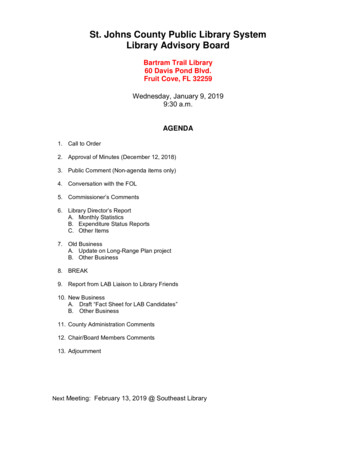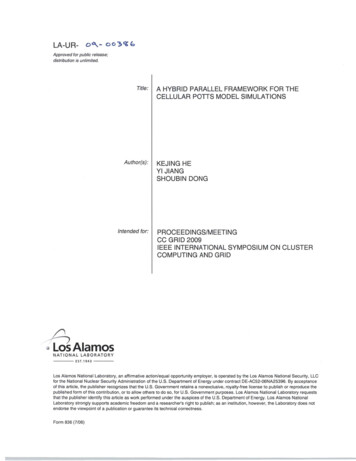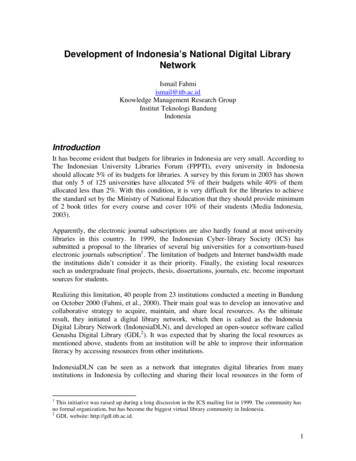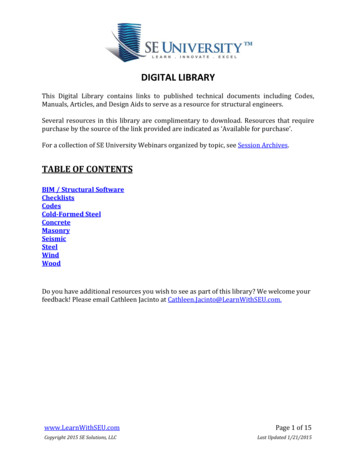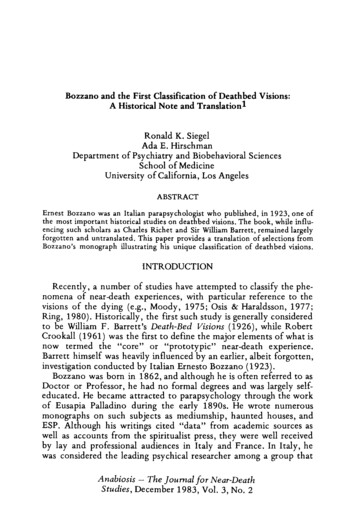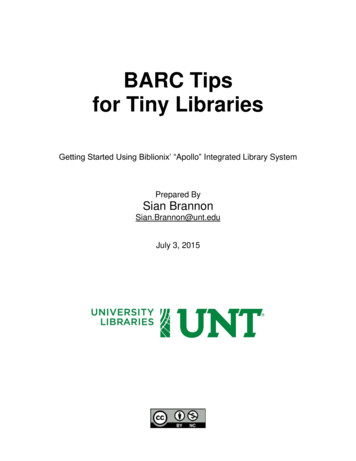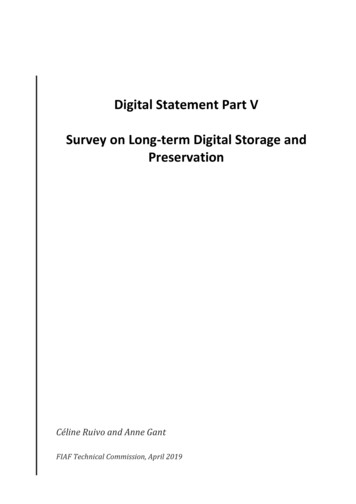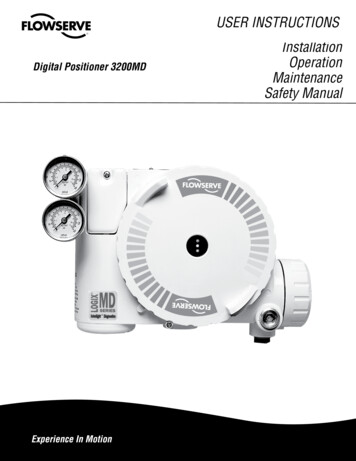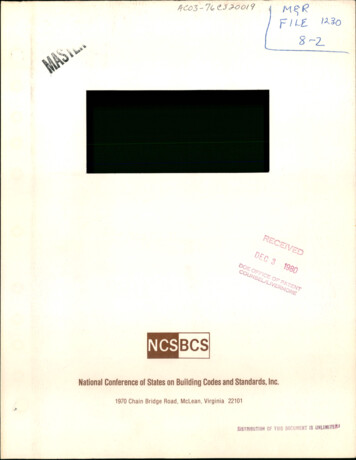
Transcription
Re.03-76 e 3)00/9,Mf F/LE/4 209 -9u2--I----I--INKpr-S»,124. .t'00. -/-'. .'.»»/.»„,./.'980.:NCSBCSNational Conference of States on Building Codes and Standards, Inc.1970 Chain Bridge Road, McLean,Virginia 22101/DISTRIBUTIO,1 ti;- 1 , ' .:'-' ·-t·WT IS UNLIMITEO'-1
DISCLAIMERThis report was prepared as an account of work sponsored by anagency of the United States Government. Neither the United StatesGovernment nor any agency Thereof, nor any of their employees,makes any warranty, express or implied, or assumes any legalliability or responsibility for the accuracy, completeness, orusefulness of any information, apparatus, product, or processdisclosed, or represents that its use would not infringe privatelyowned rights. Reference herein to any specific commercial product,process, or service by trade name, trademark, manufacturer, orotherwise does not necessarily constitute or imply its endorsement,recommendation, or favoring by the United States Government or anyagency thereof. The views and opinions of authors expressed hereindo not necessarily state or reflect those of the United StatesGovernment or any agency thereof.
DISCLAIMERPortions of this document may be illegible inelectronic image products. Images are producedfrom the best available original document.
MANAGE:tvlENT'- 'PT.;ANCONTRACT NO. EY 76-C-03-1230MODEL TRAINING PROGRAM FOR STATESAND LOCALITIESSubmitted byNATIONAL CONFERENCE OF STATES ON BUILDING CODES AND STANDARDS, INC.1970 Chain Bridge RoadMcLean, VA 22102----- --------------- ---------DISCLAIMER------------,This book was prepared as an account of work sponsored by an agency of the United States GovernmentNeither tho United Stat:s G vernment nor any agency thereof, nor any of their employees, makes an warranty, 0)(press or 1mph ed, or assumes any legal liability or responsibility for the accuracy,completeness, r usefulness of any information, apparatus, product, or process disclosed, orrepresent that ts use v.(luld not infringe privately owned rights. Reference herein 10 any specificcommerc al product, process, or service by trade name, trademark, manufacturer, or otherwise, doesnot necessarily constitute or imply its cndorsemem, recommendation, or favoring by the UnitedStates Government or any agency thereof. The views and opinions of authors expressed herein do ,.01necessarily state or reflect those of the United States Government or any agency thereof.''Iienry S. WakabayashiProgr1am Manager/.October 12, 1978- \JIL!J1STR!BUT10N Of THIS DOCUMENT ISUWLi T a
TABLE OF CONTENTSMANAGEMENT PLANI.II.·PROJECT BACKGROUND SOMMARY1PROJECT OBJECTIVES4MANAGEMENT STRUCTUREI.II.III.117BACKGROUND OF STAFF17SUBCONTRACT MANAGEMENT18PERSONNEL QUALIFICATIONS19CONSTRAINTS/PROBLEM AREAS27 .·MILESTONE PLAN AND MANAGEMENT REPORT.28MANPOWER29PLAl COST PLAN30TRAVEL PLAN31ATTACHMENT A REPORT OF AD HOC SUBCOMMITTEEON FUTURE TECHNICAL COUNCIL ACTIVITIES ANDRESPONSIBILITIESATTACHMENT B - ORGANIZATIONAL CHART OF NCSBCSAD HOC ENERGY CONSERVATION STANDING COMMITTEE
MANAGEMENT PLANI.PROJECT BACKGROUND·SUMMARYThis document is a plan for the continuation of theEnergy Conservation Program for State and Local Building CodeOfficials.The program is sponsored by the Department of Energyand carried out by a project team which includes the NationalConference of States on Building Codes. and Standards (NCSBCS),the Model Code Groups (BOCA, ICBO, SBCCI), .and the NationalAcademy of Code Administration (NACA) with the advise andcooperation of many government, industry, professional associations,· and other interested and concerned organizations.A.Brief History of the ProgramThe program actually began with the request by NCSBCS tothe National Bureau of Standards in 1972 to develop design andevaluation criteria for energy conservation in new buildings.This, in turn, lead to the development of the energy standardASHRAE 90-75 by the American Society of Heating, Refrigeratingand Air-Conditioning Engineers.Recognizing that the developmentof the basic technical standard was only the first step inachieving energy· conservation in buildings in actual practice,the Department of Energy (then ERDA) in early 1976, sponsoredthe current program to achieve four major goals: develop an enforceable model energy· code utilizingASHRAE 90-75 as the base technical document; develop and test a program of training and education,including course materials, training of instructors,and promoting courses of instruction throughout thenation;
-2- through their respective organizations, promote theadoption, promulgation and enforcement of the modelcode on a uniform, voluntary basis; coordinate these efforts·with all governmental andprivate-sector organizations to obtain maximumutilization of all available resources to reduceenergy consumption in buildings.As can be seen by the nature of the goals, the program isaction-oriented, e.g. develop the enforcement tools, train the·personnel in their use, and assist in the field use of these/tools -- utilizing all of the established building regulatoryinstitutional arrangements in a coordinated manner and drawing,upon the strengths of the traditional and well-developedvoluntary consensus system in place in the United States.B.Highlights of Results to DateBy any measure, the program to date has been eminentlysuccessful in achieving its interim goals.Key achievements.include: the Model Code for Ene·rgy Conservation in NewBuildi·ng Con·s·truction has been developed andpublished.Distribution is being accomplishedthrough the cooperative efforts of DOE, NCSBCS,and the Model Code Groups.As of September,1978, over 4000 copies have been ordered fromNCSBCS alone, and approximately 9000 copieshave bee.n distributed. by NCSBCS and the ModelCode Group. the basic training materials for the model codehave been developed and tested in prototype fieldcourses in four states.Final materials areready for publication. Materials include:-·.ECT 000 - a basic primer on energyin buildings designed forgeneral use, elected officials,etc.,ECT 100 - a course for field inspectors,
-3-ECT 200designed for plan reviewers foraverage residential, commercial,small industrial buildings,ECT 300 - a course designed for personnelconcerned with more sophisticated,complex systems such as high risebuildings, implementation activities·· have been proceeding, at timeseven before publication of final documents.For example:- ICBO's code change committee has held hearings onthe model energy code and a membership adoptionvote is expected in October for inclusion in the1979 edition of the Uniform Building Code,- SBCCI is proposing a code change to replaceAppendix J of the Standard Building Code withth model code.Hearings were held in July withthe adoption vote in October. with regard to ducation, the Mod l Code Groups, throughtheir normal educational activities are currently cdnducting courses for their members at various locationsthroughout the country, and several states are conductingcourses utilizing adaptations of the material; coordination and field awareness of the program has beenachieved using many mechanisms including:- the four prototype courses (250 attendees),- national summer institute (130 attendees),- technical council meetings,- the regular annual, semi-annual, and committee weekmeetings of NCSBCS, BOCA, ICBo·, SBCCI, NACA,- talks before a variety of association andprofessional group meetings,- specific meetings with various agencies and groupsincluding NBS, HUD, NIBS, ASHRAE, etc.In addition to the above specific accomplishments, of perhapseven greater· far-reaching importance is the achievement of this-·- -····--------·-···-·-----. ·······-------·- ·---.---- ·--- -··.-·------ .--- ---.--- . , ---------·---·· ·· ··.
-4-program in organizing what heretofore were rather diverseinstitutional mechanisms into a system for accomplishing thenecessary steps in achieving a national goal.The resultingstructure, naturally with strengthening and refinement, formsthe basis for a dynamic system to correlate the activities ofvarious groups and overcome code barriers, both technical andinstitutional, to adoption and implementation of energy-conservingregulations for buildings utilizing the voluntary consensusmechanisms.II.PROJECT OBJECTIVESIt is recognized that the full. achievement of minimumenergy use in buildings, both new and existing, will requir e longterm efforts. lThe following is a detailedtasks to be achieved under the continuingdescript on of major- con ;Phase lV - Ongoing Conduct ·of ProgramTask 1 - Update Model CodeAs ASHRAE 90-75, the basic technical standard, istipdated, it will be necessary to update the model code toreflect these changes.At present, ASHRAE 90-75 isundergoing the consensus change process and it is anticipated that 90-78 will be issued at the end of this year.The following principal tasks are considered essentialto be accomplished:l) See "Five Year Program Plan for FY '78 and Future Years, EnergyConservation Program for State and Local Building Officials",August, 1978, by H. s. Wakabayashi, Energy Program Director, NCSBCS.
I . I- 5 -a.The project team will review anq comment onASHRAE in their deliberation of revisions to 90-75.b.The project team attended the ASHRAE semi-annual meeting in Albuquerque, New Mexico.c.The preliminary code update procedure willbe reviewed by all concerned organizations andfinalized.d.The project team will attend the ASHRAEannual meeting in Philadelphia in late January 1979to keep updated on the issuance of ASHRAE 90-75R (orASHRAE 90-7 8) .e.Development of the· final planning report ascalled for in the contract will be initiated shortlyafter the ASHRAE meeting iri Philadelphia.
-6-Task 2.- Monitoring ProcessThis will be a low-level activity since it isanticipated· that NIBS will be developing a system toaccomplish this function.NCSBCSwill work closelywith NIBS to insure that any system includes monitoringof training as well as adoption of the code, and thatfeed-back is relayed to the project team.An interim report indicating the progress of thistask will be submitted on or before 31 December 197.8.
-7-Task 3 - Training Materiala.The impact of ASHRAE 90-75R on the educationalmaterials packages will be determined.Actual changesin the packages will not be made until the code is updated.b.A detailed review and specific identificationof visual training aids (slides and transparencies)foruse by instructors will be conducted.c.Supplementary examinations and homework problemswill be developed.d.To assure that state and local government policyand decision-makers, code administrators, building inspectors,and plan examiners are aware of the scope and details of theModel Code and training program, it is important to activelydisseminate information on ·this program to these audiences.The development of a video-taped presentation willbe prepared to reach the above mentioned audiences on alocal level.This presentation will record a meeting of theprincipal participants in the Model Energy ConservationBuilding Code Program.This includes representatives ofDOE, NCSBCS and other appropriate program participants.The contractor shall conduct the following tasks:1.Develop a discussion agenda.2.Arrange for participants.3.Arrange for appropriate visuals.4.Prepare duplicate copies of the videotape presentation.5.Distribute video-tapes to organizationsupon request.
-8-Task 4 - Qualified InstructorsA key aspect of an effective implementation and enforcement program will be the availability of instructors at thestate and local levels who are qualified to conduct coursesfor the building officials.This will be accomplished by aseries of regional seminars or institutes which will be conducted over a multi-year period.Three institutes have been conducted for the training ofinstructors to teach the ECT-100 and ECT-200 courses.Theinitial institute was held at the University of Utah in 1977and the subsequent institutes were held at the Universityof Colorado and the University of Maine during the summer of1978.All sessions were five days in length with a total of133 state representatives participating.In this task, NACA will. be involved.to insure that theseprograms are coordinated with a national plan for accreditingand training programs for certifying building officials.Overall critiques and comments submitted by the· participantsindicate that these sessions were outstanding in every respectand fulfilled a much-needed requirement.
-9-Task 5 - Training Program for States and LocalitiesVarying and heterogeneous trainirig programs are beingimplemented by states in which the basic ECT educational15eries developed under this contract are. being utilized.Under this task, a report will be rendered whereincomments, recommendations and proposed training andeducation programs for states and localities will beaddressed.
-10-Task 6 - Regional Advisory Service CenterGiven a situation wherein a state or a local jurisdiction has enacted appropriate legislation or regulationsfor the adoption of the Madel Code for Energy Conservationin New Building Construction or Model Document for CodeOfficials on Solar Heating and Cooling of Buildings, it thenbecomes the inherent responsibility of the building code·officials of that jurisdiction to implement and enforcethe adopted regulatory provisions.-In a large measure,the training and education program will provide substantialassistance to those responsible for the enforcement aspectof the code.However, training sessions alone are notconsidered to be wholly responsive to the enforcementand implementation phase of the code.Thus, it is necessaryto make available to these state and local officials chargedwith the responsibility of implementing and enforcing thecode, a centralized resource of technical expertise toprovide assistance and advisory services on complex technicalmatters of the model code and other code-related issues.Therefore, as a significant part of the implementation andenforcement aspect of this program, two regional advisoryservice centers will be established on a prototype basisto ascertain the need for; determine the objectives/scopeof work of; and ascertain required staffing pattern for apermanent and expanded program.
- 11 -One of the first projects to be undertaken by thecenters will be a survey of state building and energy officialsto ascertain their critical needs. for technical advice and todetermine what technical resources are currently availableto them.Presently, a prototype advisory·center has been establishedin New Mexico with substantial financial and personnel assistancebeing furnished at no expense toNCSBCS or the Federal government.The second site for the two advisory service centers, as calledfor under the contract, is presently being negotiated.It isanticipated that the second site will be finalized by November,1978.
-12-Task 7 - Winter SeminarAs a result of the highly successful seminar heldduring the summer of 1977 at the. University of Utahfor representatives of all the states, a follow-onwinter seminar was held in Albuquerque, New Mexico,in February 1978 to update state· personnel onnational and state energy code activities and developments.Over 100 state energy and building code representativesattended and were brought up-to-date on the progress in allof the major energy programs now under way including: New construction (90-75)0Retrofit program (lOO-P)0Solar program@;)HUD performance standard0Operation & maintenanceComments and critiques submitted by the participantsindicate that· the seminar objectives were very successfullyachieved and that they unanimously recommended that asimilar session be held in the near future.
-13-Task 8 - Liaison With Other Code-Related OrganizationsUp to this point in the program the project team has,addressed the issue of uniformity through their respectiveorganizations, e.g. NCSBCS, which is made up of stateregulatory officials; and the model code groups, who havetraditionally serviced the needs of local communities.Asubstantial number of larger cities, .however, have developedtheir own codes.to suit the particular needs of high-densityurban popcilations.These larger cities have formed tbeAssociation of Major City Building Officials (AMCBO).It is planned to actively enlist these larger citiesthrough their organization, AMCBO, to actively participatein the energy code development, update and implementationprocess.The inclusion of AMCBO in this process on a moreactive basis will assist greatly in obtaining uniform energyprovisions in all jurisdictions.Other liaison activities completed and in processinclude:a.meeting of project team with ASHRAE in Atlanta inFebruary, 1978;b.meeting of project team in Phoenix in February toreview progress and formulate detail d plans forenergy program activities;c.meeting of the project team and the TechnicalCouncil in Burlington, Vermont in March;d.meeting of the project team and the TechnicalCouncil in Portland, Oregon in June.
-14-Task 9 - Technical CouncilThe Technical Council, established under theprovisions of the ·original contract, involvedprincipally the review of educational materialswhich were developed to support the implementationof. the Model Code for Energy Conservation in NewBuilding Construction.In a large measure, the objectives of the originalcharter of the Technical Council have been fulfilledby the involvement by various Technical Council membersin the completion of several educational activitiesas follows: Review of the original educational coursematerials.oObservers. in various prototype courses of theEnergy Conservation Technology Series. Assisting in the screening and selection ofSummer Institute applications. Participating in the Summer Institute sessionsfor qualified instructors.oParticipating in other related educationalactivities.Subsequent developments under the contract strongly1indicate that the role of the Technical Council shouldbe enlarged or expanded to become more germane to thedeveloping needs.As a result, an ad hoc committee
- 15 -was formed to conduct such a study and to submitrecommendations thereon.This report was completedin the summer of 1978 and a copy is attached.(Attachment A)In the meantime,· the NCSBCS Board of Directorshas authorized the establishment of an ad hocEnergy Conservation Committee.A tentativeorganizational chart of this ad hoc committee isattached.(Attachment B)The proposed NCSBCS Ad Hoc Committee expandssubstantially on the scope of the DOE/NCSBCSTechnical Council to include a wider involvementin all energy matters, including for example, theissue of implementation of codes at state andlocal levels, concerns of consumer interests,public utilities and other energy conservationissues.In light of the NCSBCS establishment of itsown independent Energy Conservation Committee, asecond ad hoc committee of the Technical Councilhas been formed to review and analyze·the expandedrole of the Technical Council in the light of NCSBCSactions.This ad hoc committee is scheduled to meetin early November to complete its r·ecommendations todelineate and possibly amalgamate the roles of thetwo separate organizations presently envisioned.A report of the ad hoc committee will be submittedfor discussion in the December meeting of the TechnicalCouncil.
- 16 -Phase V - Development of Energy Conserv tion Code and TrainingProgram for Existing BuildingsTask 1 - Model Energy Conservation Code for ExistingBuildingsASHBAR 100, the standard forene gyconservation inexisting buildings,is well along in the review process andit is imperative that the project team be in a position tomove quickly on· code development when the Standard isfinalized.onth Also, there is a substantial amount of activityfederal, state and local levels inr gardto thedevelopment of a separate rehabilitation code for existingbuildings.It is important that these. programs be monitoredto insure that de
!j1str!but10n of this document is uwli t _a -----'-----""'" table of contents management plan i. project background sommary ii.· project objectives management

